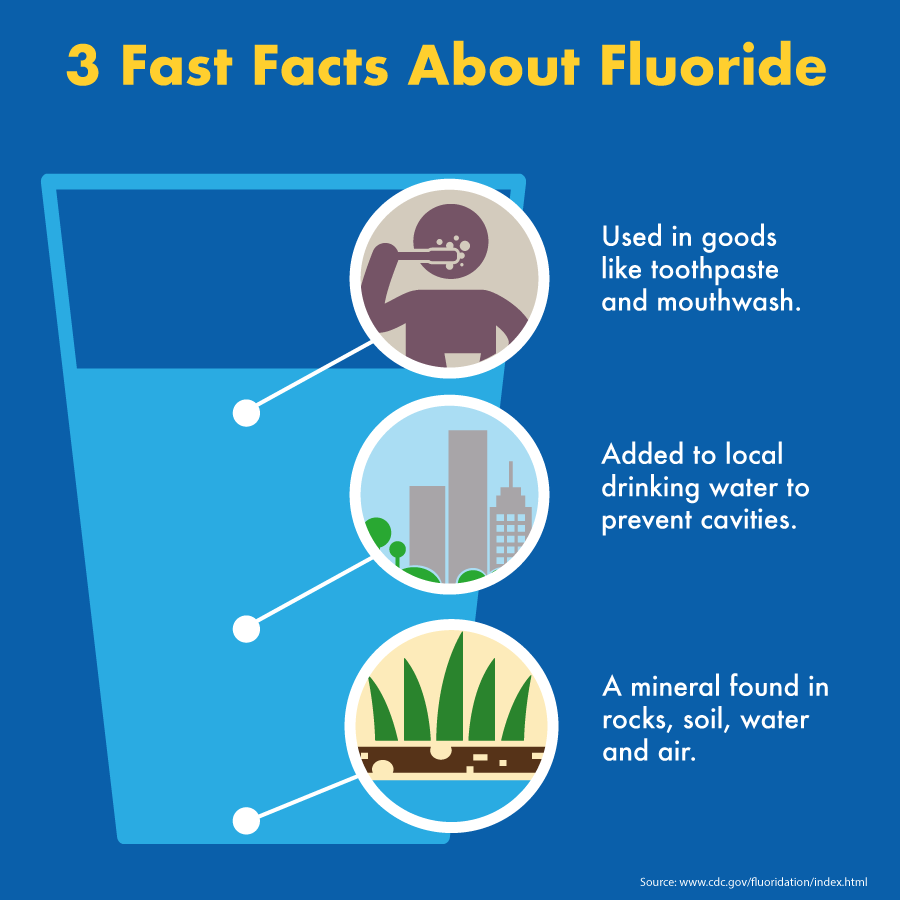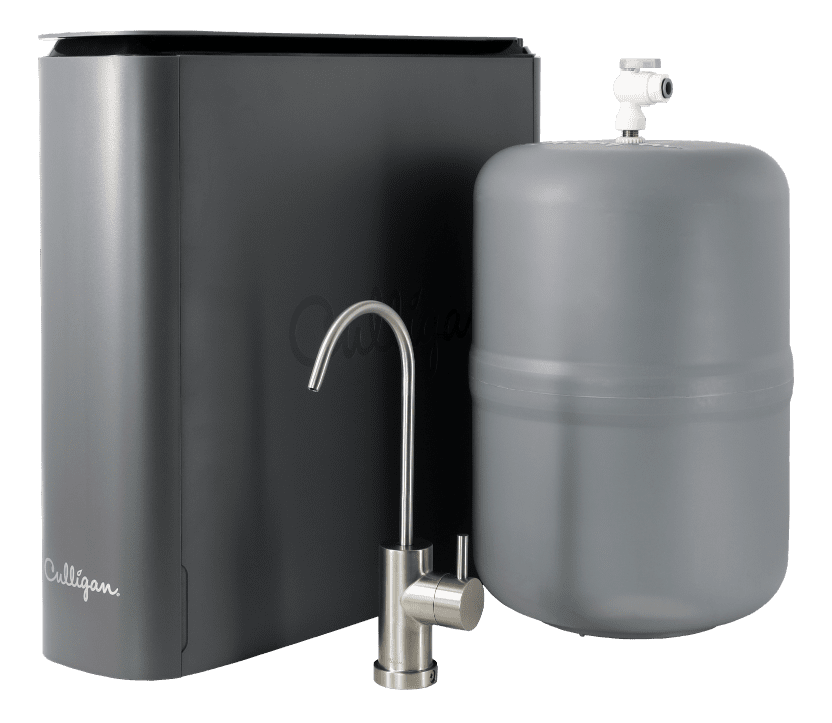Is Fluoride in Drinking Water a Good or Bad Thing?
A mineral with health benefits as well as risks, let's take a closer look at fluoride and its prevalence in drinking water supplies.
Posted in
Contaminant,
Culligan Nation,
Drinking Water,
Drinking Water System,
Tap Water,
Water Problems
What is fluoride?
Fluoride is a natural mineral found in rocks, soil, water and air. And though it is an organic mineral, it is also added to everyday items. Like toothpaste, mouthwash and even water. In the United States, about 75 percent of fluoride consumption comes from water and processed drinks. Such as fruit juices and sodas.
Is it safe?
Yes. In fact, many people consider fluoride to be a beneficial mineral. Fluoride helps prevent tooth decay and cavities.
The enamel of a tooth should be solid and strong. But certain substances like sugar and refined carbohydrates create bacteria in the mouth that destroy tooth enamel. However, fluoride neutralizes this bad bacteria. Keeping enamel strong and healthy.

What about fluoride in drinking water?
Because fluoride is a natural mineral, it is found in most drinking water. But usually in very small amounts. State and local levels of government then add fluoride to public water supplies. Which is a process called fluoridation.
In addition to fluoride in drinking water, it exists in toothpaste, food and drinks, prescription or dietary supplements, and other professional dental products like mouthwash, gels and foams.
A Brief History of Fluoridation
The Center for Disease Control and Prevention (CDC) considers fluoridation to be one of the most successful public health stories. Grand Rapids, Michigan, became the first city to fluoridate its water back in 1945.
As a fluoride pioneer, Grand Rapids released a study in 1950 about the results of fluoridation. The results showed that children in Grand Rapids had fewer cavities than children living in nearby cities.
Over the years, adding fluoride to water has been credited with lowering the rates of tooth decay in the United States. By 2014, more than 211 million people drank enough fluoridated water to prevent tooth decay. That equates to roughly three in four Americans.
How much is recommended?
United States Public Health Service (PHS) recommends community water fluoridation maintains level of 0.7mg/L (parts per million) to provide preventative benefits. This level also reduces the risk of dental fluorosis. Which can be damaging.
According to the PHS, if your child drinks the recommended amount of fluorinated water, then he/she is receiving the optimal amount of fluoride. They additionally recommended that children start using toothpaste containing fluoride when they are two years old.
If your child is younger, toothpaste with fluoride should be advised specifically by a dentist or doctor. And any child under the age of six should use no more than small, pea-sized amounts of toothpaste.
What are the dental health benefits of fluoride?
- Shown to reduce cavities in kids and adults.
- Lowers the intensity of cavities.
- Causes less fillings and tooth extractions.
- Minimizes pain that comes with tooth decay.
- Prevents tooth decay.
- Strengthens tooth enamel.
- Helpful for teeth of all ages, from kids to adults.
The CDC argues that not only is fluoride safe to consume in water, but it is also effective. Because fluoridated water keeps minimal amounts of fluoride in the mouth throughout the day.
This allows fluoride to actively fights tooth decay at all times. In fact, communities with fluoridated water have 25 percent less cavities than communities without.
But are there health risks?
Every person reacts to minerals differently. Fluoride is no different. As with all minerals, there is danger in overexposure. However, the amount of fluoride in drinking water is typically not enough to cause fluoride toxicity and neurotoxicity.
Dental Fluorosis
Dental Fluorosis, or fluoride toxicity, is a direct result of overexposure to fluoride. Teeth become permanently damaged with discoloration and white or brown mottling. In addition, teeth become brittle, break and stain easily.
According to the CDC, about 23 percent of Americans between the ages of 6-49 exhibited some level of dental fluorosis in 2010. And 41 percent of children between the ages of 12-15 showed signs. Because of these numbers, the CDC recommended that lower levels of fluoride be added to municipal water supplies in 2015.
Neurotoxicity
Neurotoxicity occurs when the exposure to natural or man made toxic substances alters the normal activity of the nervous system. This is considered another risk of overexposure to minerals such as fluoride.
What about fluoride not found in water?
Aside from drinking water, we also find fluoride in a variety of other foods and products.
Some popular beverages that contain higher levels of fluoride include: beer, wine, juice, soft drinks, infant formula, tea, bottled water and commercial beverages.
Different kinds of pesticides also contain higher levels of fluoride. For example, insecticides like cryolite. And sulfuryl fluorides such as fumigant.
But we use the most fluoride-dominant products for dental care. Products such as toothpaste, mouthwash, dental floss, fluoridated toothpicks and topical fluoride contain high levels of the mineral. Which assists in preventing and managing tooth decay and cavity development.
Are there ways to remove fluoride from drinking water?
Reverse Osmosis Systems
If you're worried about the presence of fluoride in your drinking supply, consider a Culligan Reverse Osmosis System. Because it eliminates contaminants other filters miss.
Reverse Osmosis, commonly called RO, reduces contaminants like arsenic, sodium and chloride. And it reduces minerals like fluoride and radium. Plus harmful microorganisms living in drinking water.
Benefits of Culligan Reverse Osmosis Systems:
- Remove dissolved organic and inorganic compounds from water.
- Reduce contaminants and minerals like sodium, chloride, fluoride and nitrates.
- Eliminate bad smelling and tasting chlorine or sulfur.
- Minimize levels of harmful pesticides and other chemicals.
- Provide better-tasting, cleaner water.
- Prevent scale buildup in plumbing and appliances, as well as stains in bathtubs, sinks and dishes.

How does Reverse Osmosis Filtration Work?
When it comes to understanding the process of reverse osmosis filtration, it is helpful to separate the process into four unique steps. These steps include pre-filtration, reverse osmosis, drainage and storage.
First, pressurized water moves through a particle filter. This removes impurities like salt, sediment and sand.
Second, water passes through an activated carbon filter. Which traps and removes minerals and contaminants like chlorine, mercury, copper, fluoride and pesticides.
We consider these first two steps pre-filtration.
Next, pressure pushes the water through a semipermeable membrane. Trapping even the smallest impurities. This is the reverse osmosis step.
Finally, the discharge step flushes away all of the removed contaminants. And the treated water moves into a storage tank.
Before entering the faucet, the water goes through one final activated-carbon filtration. Which improves the taste and quality for household use.
Culligan ClearLinkPRO
Is is really possible have cleaner, better-tasting water at the touch of a button? With the ClearLinkPRO™, that answer is a yes.
How does it work?
The ClearLinkPRO™ connects to the main faucet. Simply turn on the cold water. And push the ClearLinkPRO ™ button.
It switches the faucet from unfiltered to filtered water in seconds. To turn off the filtration system, simply turn off the water. And the faucet will automatically revert back to using unfiltered water.

